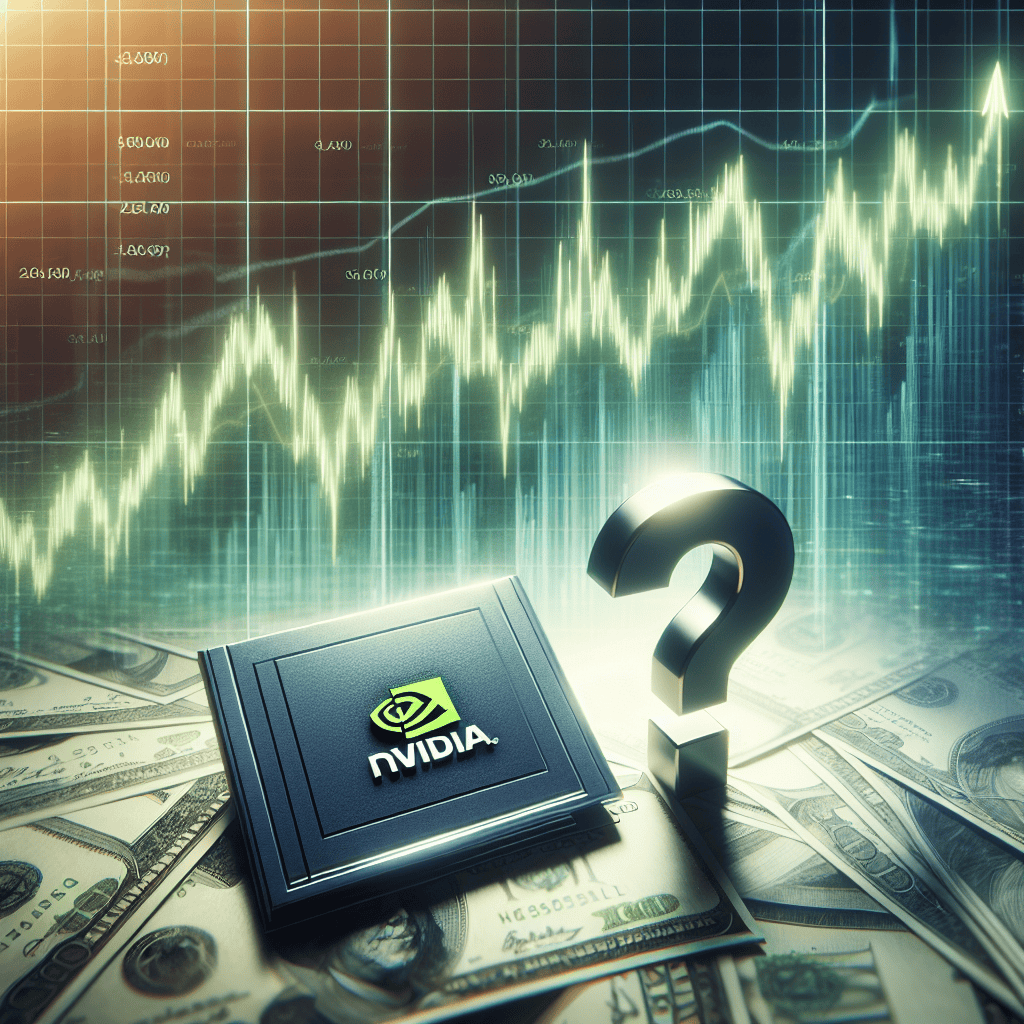“Riding the Wave: Is Nvidia’s Record Surge Your Next Big Investment Opportunity?”
Introduction
Nvidia Corporation, a leading player in the semiconductor industry, has recently seen its stock reach record highs, capturing the attention of investors and market analysts alike. This surge comes ahead of the company’s much-anticipated earnings report, which is expected to provide insights into its financial health and future growth prospects. Nvidia’s impressive performance can be attributed to its dominance in the graphics processing unit (GPU) market, its strategic expansion into artificial intelligence (AI) and data center technologies, and its ability to capitalize on the growing demand for high-performance computing solutions. As the company continues to innovate and expand its product offerings, potential investors are keenly evaluating whether now is the right time to invest in Nvidia, considering both the opportunities and risks associated with its current market position.
Nvidia’s Market Surge: Analyzing the Factors Behind the Record High
Nvidia, a leading player in the semiconductor industry, has recently reached a record high in its stock price, capturing the attention of investors and analysts alike. This surge comes ahead of the company’s key earnings report, prompting many to question whether now is the right time to invest. To understand the factors driving this remarkable performance, it is essential to delve into the various elements contributing to Nvidia’s current market position.
First and foremost, Nvidia’s success can be attributed to its dominance in the graphics processing unit (GPU) market. As the demand for high-performance computing continues to grow, Nvidia has positioned itself as a critical supplier of GPUs, which are essential for a wide range of applications, from gaming to artificial intelligence (AI) and data centers. The company’s innovative approach to GPU design and its ability to consistently deliver cutting-edge technology have solidified its reputation as a leader in the industry. This technological prowess has not only bolstered Nvidia’s market share but also enhanced investor confidence in its long-term growth prospects.
Moreover, the increasing adoption of AI across various sectors has further fueled Nvidia’s ascent. As AI technologies become more integrated into industries such as healthcare, automotive, and finance, the demand for powerful computing solutions has surged. Nvidia’s GPUs are particularly well-suited for AI workloads, making the company a preferred choice for businesses seeking to harness the potential of AI. This trend is expected to continue, providing Nvidia with a robust growth trajectory in the coming years.
In addition to its technological advancements, Nvidia’s strategic acquisitions have played a significant role in its market surge. The company’s acquisition of Mellanox Technologies, a leader in high-performance computing and networking solutions, has expanded Nvidia’s capabilities and strengthened its position in the data center market. This move has not only diversified Nvidia’s product offerings but also opened new revenue streams, contributing to its impressive financial performance.
Furthermore, Nvidia’s commitment to sustainability and energy efficiency has resonated with environmentally conscious investors. The company has made significant strides in developing energy-efficient GPUs, which are crucial in reducing the carbon footprint of data centers and other computing-intensive operations. This focus on sustainability aligns with the growing emphasis on environmental, social, and governance (ESG) criteria among investors, enhancing Nvidia’s appeal in the market.
However, despite these positive factors, potential investors should also consider the challenges and risks associated with investing in Nvidia. The semiconductor industry is highly competitive, with rapid technological advancements and shifting market dynamics. Nvidia faces competition from other major players, such as AMD and Intel, which are also vying for market share in the GPU and AI sectors. Additionally, geopolitical tensions and supply chain disruptions could impact Nvidia’s operations and profitability.
In conclusion, Nvidia’s record high stock price is a testament to its strong market position, driven by its technological leadership, strategic acquisitions, and commitment to sustainability. While the company’s future prospects appear promising, potential investors should carefully weigh the opportunities against the inherent risks in the semiconductor industry. As Nvidia prepares to release its key earnings report, it will be crucial for investors to stay informed and consider both the short-term market conditions and the long-term growth potential before making investment decisions.
Key Earnings Preview: What to Expect from Nvidia’s Financial Report
Nvidia, a leading player in the semiconductor industry, has recently reached record highs in its stock price, capturing the attention of investors and analysts alike. As the company approaches its key earnings report, many are eager to understand what this financial disclosure might reveal about Nvidia’s current performance and future prospects. The anticipation surrounding this earnings report is palpable, as it could provide crucial insights into the company’s strategic direction and its ability to maintain its competitive edge in a rapidly evolving market.
To begin with, Nvidia’s recent stock performance can be attributed to several factors, including its strong position in the graphics processing unit (GPU) market and its expanding influence in artificial intelligence (AI) and data center technologies. The company’s GPUs are not only essential for gaming but also play a critical role in AI applications, which have seen a surge in demand across various industries. This dual market presence has allowed Nvidia to capitalize on multiple growth opportunities, thereby driving its stock to unprecedented levels.
As we look forward to Nvidia’s upcoming earnings report, several key metrics will be under scrutiny. Revenue growth is expected to be a focal point, as it will indicate how well the company is capitalizing on its market opportunities. Analysts will also be keen to examine Nvidia’s profit margins, which could provide insights into the company’s operational efficiency and pricing power. Furthermore, any updates on Nvidia’s product pipeline, particularly in the AI and data center segments, will be closely watched, as these areas are considered pivotal for the company’s long-term growth strategy.
In addition to these financial metrics, investors will be interested in Nvidia’s guidance for the coming quarters. The company’s outlook will be crucial in assessing whether its current growth trajectory is sustainable. Given the competitive nature of the semiconductor industry, Nvidia’s ability to innovate and adapt to changing market dynamics will be essential for maintaining its leadership position. Therefore, any commentary from Nvidia’s management regarding future product launches, strategic partnerships, or market expansion plans will be of significant interest.
Moreover, Nvidia’s earnings report will likely address the broader economic environment and its impact on the company’s operations. Supply chain challenges, geopolitical tensions, and fluctuating demand patterns are all factors that could influence Nvidia’s performance. Investors will be eager to understand how the company is navigating these challenges and what measures it is taking to mitigate potential risks.
As Nvidia prepares to release its earnings, potential investors are faced with the question of whether now is the right time to invest in the company. While Nvidia’s recent stock performance and market position are undoubtedly impressive, investing in the semiconductor industry carries inherent risks. Market volatility, technological disruptions, and competitive pressures are all factors that could impact Nvidia’s future performance. Therefore, prospective investors should carefully consider these risks alongside the company’s growth prospects before making any investment decisions.
In conclusion, Nvidia’s upcoming earnings report is poised to be a significant event for the company and its stakeholders. The insights gleaned from this financial disclosure will not only shed light on Nvidia’s current performance but also provide valuable guidance on its future trajectory. As the company continues to navigate a complex and dynamic market landscape, its ability to deliver on its strategic objectives will be crucial in determining whether it can sustain its recent success and continue to create value for its shareholders.
Investment Strategies: Is Now the Right Time to Buy Nvidia Stock?
Nvidia, a leading player in the semiconductor industry, has recently reached record highs in its stock price, capturing the attention of investors worldwide. This surge comes ahead of the company’s key earnings report, prompting many to question whether now is the opportune moment to invest in Nvidia stock. To make an informed decision, it is essential to consider several factors, including the company’s financial performance, market position, and broader industry trends.
First and foremost, Nvidia’s financial performance has been nothing short of impressive. The company has consistently demonstrated strong revenue growth, driven by its dominance in the graphics processing unit (GPU) market. GPUs are critical components in various high-demand sectors, such as gaming, data centers, and artificial intelligence (AI). Nvidia’s ability to innovate and deliver cutting-edge technology has solidified its position as a market leader, allowing it to capitalize on the growing demand for advanced computing solutions. As a result, the company’s financial health appears robust, with analysts predicting continued growth in the coming quarters.
In addition to its financial performance, Nvidia’s strategic positioning within the semiconductor industry further bolsters its investment appeal. The company has successfully diversified its product offerings, expanding beyond traditional gaming GPUs to include AI and machine learning applications. This diversification strategy has enabled Nvidia to tap into new revenue streams and reduce its reliance on any single market segment. Moreover, Nvidia’s recent acquisition of Arm Holdings, a leading semiconductor design company, is expected to enhance its competitive edge by broadening its technological capabilities and market reach.
However, while Nvidia’s prospects appear promising, potential investors must also consider the broader industry landscape. The semiconductor industry is characterized by rapid technological advancements and intense competition. Companies must continuously innovate to maintain their market positions, and Nvidia is no exception. Although Nvidia has a strong track record of innovation, there is always the risk that competitors could develop superior technologies, potentially eroding Nvidia’s market share. Furthermore, the industry is subject to cyclical fluctuations, with periods of high demand often followed by downturns. Investors should be mindful of these inherent risks when evaluating Nvidia as a potential investment.
Another factor to consider is the current valuation of Nvidia’s stock. The recent surge in its stock price has led to concerns about overvaluation, with some analysts cautioning that the stock may be trading at a premium relative to its intrinsic value. While Nvidia’s growth prospects are undoubtedly strong, investors should carefully assess whether the current stock price accurately reflects the company’s future earnings potential. It is crucial to conduct thorough research and consider various valuation metrics before making an investment decision.
In conclusion, Nvidia’s record-high stock price ahead of its key earnings report presents both opportunities and challenges for potential investors. The company’s strong financial performance, strategic market positioning, and innovative capabilities make it an attractive investment option. However, investors must also weigh the risks associated with the competitive and cyclical nature of the semiconductor industry, as well as the current valuation of Nvidia’s stock. By carefully considering these factors and conducting comprehensive research, investors can make a more informed decision about whether now is the right time to invest in Nvidia stock.
Nvidia’s Growth Potential: Long-term Prospects for Investors

Nvidia, a leading player in the semiconductor industry, has recently reached record highs in its stock price, capturing the attention of investors worldwide. This surge comes ahead of the company’s key earnings report, prompting many to consider whether now is the right time to invest. To understand Nvidia’s growth potential and long-term prospects, it is essential to examine the factors driving its success and the challenges it may face in the future.
One of the primary drivers of Nvidia’s recent success is its dominance in the graphics processing unit (GPU) market. GPUs are critical components in a wide range of applications, from gaming and professional visualization to data centers and artificial intelligence (AI). Nvidia’s innovative products, such as the GeForce and Quadro series, have set industry standards, making the company a preferred choice for consumers and businesses alike. As the demand for high-performance computing continues to grow, Nvidia is well-positioned to capitalize on these trends, further solidifying its market leadership.
Moreover, Nvidia’s strategic investments in AI and machine learning have opened new avenues for growth. The company’s AI platforms, such as the Nvidia AI Enterprise suite, provide comprehensive solutions for businesses looking to harness the power of AI. These platforms are designed to accelerate the deployment of AI applications across various industries, including healthcare, automotive, and finance. As AI becomes increasingly integral to business operations, Nvidia’s expertise in this area is likely to drive sustained growth.
In addition to its core GPU business, Nvidia’s acquisition of Arm Holdings, a leading semiconductor and software design company, has the potential to significantly enhance its long-term prospects. This acquisition, if successfully completed, would expand Nvidia’s reach into the central processing unit (CPU) market, allowing it to offer a more comprehensive suite of products. By integrating Arm’s technology with its own, Nvidia aims to create a robust ecosystem that supports a wide range of computing needs, from edge devices to cloud data centers.
However, despite these promising developments, potential investors should also consider the challenges Nvidia may encounter. The semiconductor industry is highly competitive, with companies like AMD and Intel constantly vying for market share. Nvidia must continue to innovate and differentiate its products to maintain its competitive edge. Additionally, the ongoing global semiconductor shortage poses a risk to Nvidia’s supply chain, potentially impacting its ability to meet growing demand.
Furthermore, regulatory hurdles could complicate Nvidia’s acquisition of Arm. Antitrust concerns have been raised by various governments, which could delay or even block the deal. Investors should closely monitor these developments, as the outcome could significantly influence Nvidia’s future trajectory.
In conclusion, Nvidia’s record-high stock price reflects its strong position in the semiconductor industry and its potential for long-term growth. The company’s leadership in GPUs, strategic focus on AI, and potential expansion into the CPU market through the Arm acquisition all contribute to its promising outlook. However, investors should remain vigilant regarding the competitive landscape, supply chain challenges, and regulatory issues that could impact Nvidia’s growth. By carefully weighing these factors, investors can make informed decisions about whether to invest in Nvidia as it continues to navigate the dynamic technology landscape.
Risks and Rewards: Evaluating Nvidia’s Stock Volatility
Nvidia’s recent surge to record highs has captured the attention of investors worldwide, prompting a closer examination of the risks and rewards associated with investing in this tech giant. As the company approaches its key earnings report, potential investors are weighing the volatility of Nvidia’s stock against its promising growth prospects. Understanding the factors contributing to this volatility is crucial for making informed investment decisions.
To begin with, Nvidia’s impressive performance can be attributed to its leadership in the graphics processing unit (GPU) market, which has seen exponential growth due to the increasing demand for high-performance computing. The company’s GPUs are not only essential for gaming but also play a critical role in artificial intelligence (AI), data centers, and autonomous vehicles. This diversification has allowed Nvidia to tap into multiple high-growth markets, thereby driving its stock price to unprecedented levels. However, with such rapid growth comes inherent volatility, as the stock is susceptible to fluctuations based on market sentiment and technological advancements.
Moreover, Nvidia’s stock volatility is further influenced by the broader semiconductor industry, which is characterized by cyclical demand and supply chain challenges. The global chip shortage, for instance, has impacted production timelines and increased costs, creating uncertainty in the market. While Nvidia has managed to navigate these challenges effectively, any disruptions in the supply chain could lead to significant stock price fluctuations. Additionally, the competitive landscape poses a risk, as companies like AMD and Intel continue to innovate and vie for market share. This competition could potentially erode Nvidia’s market dominance, affecting its long-term growth trajectory.
On the other hand, Nvidia’s strategic acquisitions and partnerships have positioned it well for future growth, offering potential rewards for investors. The acquisition of ARM Holdings, although facing regulatory hurdles, is expected to enhance Nvidia’s capabilities in the mobile and Internet of Things (IoT) sectors. Such strategic moves could provide Nvidia with a competitive edge, further solidifying its position in the tech industry. Furthermore, Nvidia’s commitment to research and development ensures that it remains at the forefront of technological innovation, which is crucial for maintaining its market leadership.
In addition to these strategic initiatives, Nvidia’s financial performance has been robust, with consistent revenue growth and strong profit margins. The company’s ability to generate substantial cash flow provides it with the flexibility to invest in new technologies and expand its market presence. This financial strength is a reassuring factor for investors, as it indicates Nvidia’s capacity to weather economic downturns and capitalize on emerging opportunities.
Nevertheless, potential investors must consider the inherent risks associated with Nvidia’s stock volatility. The tech sector is notoriously unpredictable, and external factors such as regulatory changes, geopolitical tensions, and economic shifts can significantly impact stock performance. Therefore, it is essential for investors to conduct thorough research and assess their risk tolerance before making investment decisions.
In conclusion, while Nvidia’s record-high stock price and promising growth prospects present enticing opportunities, the associated volatility cannot be overlooked. By carefully evaluating the risks and rewards, investors can make informed decisions about whether to invest in Nvidia ahead of its key earnings report. As with any investment, a balanced approach that considers both potential gains and risks will be crucial in navigating the complexities of the stock market.
Comparing Nvidia with Competitors: A Market Position Analysis
Nvidia’s recent surge to a record high has captured the attention of investors and analysts alike, prompting a closer examination of its market position relative to its competitors. As the company approaches its key earnings report, understanding its standing in the semiconductor industry becomes crucial for potential investors. Nvidia’s dominance in the graphics processing unit (GPU) market is well-documented, with its products being integral to gaming, data centers, and artificial intelligence applications. This stronghold has allowed Nvidia to maintain a competitive edge over rivals such as AMD and Intel, both of which are formidable players in the semiconductor space.
To begin with, Nvidia’s technological advancements have consistently set it apart from its competitors. The company’s GPUs are renowned for their superior performance and efficiency, which are critical factors in high-demand applications like AI and machine learning. This technological prowess is not only a testament to Nvidia’s innovative capabilities but also a significant barrier for competitors attempting to capture market share. AMD, for instance, has made strides with its Radeon series, yet it still trails Nvidia in terms of market penetration and brand recognition. Intel, traditionally dominant in the CPU market, has also ventured into the GPU arena with its Xe series, but it faces an uphill battle in matching Nvidia’s established reputation and customer loyalty.
Moreover, Nvidia’s strategic acquisitions have bolstered its market position, further differentiating it from its competitors. The acquisition of Mellanox Technologies, a leader in high-performance computing and networking solutions, has expanded Nvidia’s reach into data centers, a sector experiencing exponential growth. This move not only diversifies Nvidia’s portfolio but also strengthens its foothold in a lucrative market segment. In contrast, AMD and Intel have pursued different strategies, with AMD focusing on organic growth and Intel investing heavily in manufacturing capabilities. While these approaches have their merits, Nvidia’s ability to integrate complementary technologies through acquisitions provides it with a unique competitive advantage.
In addition to technological and strategic factors, Nvidia’s financial performance underscores its robust market position. The company’s revenue growth has been impressive, driven by strong demand across its core markets. This financial strength enables Nvidia to invest heavily in research and development, ensuring it remains at the forefront of innovation. AMD, while experiencing significant growth, particularly in the gaming console market, does not yet match Nvidia’s financial clout. Intel, on the other hand, has faced challenges in maintaining its growth trajectory, partly due to increased competition and supply chain disruptions.
Furthermore, Nvidia’s commitment to sustainability and corporate responsibility enhances its appeal to a growing segment of socially conscious investors. The company has made significant strides in reducing its carbon footprint and promoting ethical business practices, aligning with global trends towards environmental and social governance (ESG) criteria. This focus on sustainability not only differentiates Nvidia from its competitors but also positions it favorably in the eyes of investors prioritizing ESG factors.
In conclusion, Nvidia’s record high ahead of its key earnings report is a reflection of its strong market position relative to competitors like AMD and Intel. Its technological leadership, strategic acquisitions, financial performance, and commitment to sustainability collectively contribute to its competitive edge. For potential investors, these factors warrant careful consideration when evaluating Nvidia as an investment opportunity. As the semiconductor industry continues to evolve, Nvidia’s ability to maintain its leadership will be pivotal in determining its long-term success.
Expert Opinions: What Analysts Are Saying About Nvidia’s Future
Nvidia, a leading player in the semiconductor industry, has recently reached record highs in its stock price, capturing the attention of investors and analysts alike. This surge comes ahead of the company’s much-anticipated earnings report, prompting a flurry of expert opinions on whether now is the right time to invest in Nvidia. As the company continues to dominate the graphics processing unit (GPU) market and expand its influence in artificial intelligence (AI) and data centers, analysts are keenly evaluating its future prospects.
To begin with, Nvidia’s impressive performance can be attributed to its strong foothold in the GPU market, which remains a critical component for gaming, professional visualization, and increasingly, AI applications. The company’s GPUs are renowned for their high performance and efficiency, making them the preferred choice for both consumers and enterprises. This dominance has allowed Nvidia to capitalize on the growing demand for advanced computing solutions, particularly as AI technologies become more integrated into various industries.
Moreover, Nvidia’s strategic acquisitions and partnerships have further bolstered its position in the tech landscape. The acquisition of Mellanox Technologies, for instance, has enhanced Nvidia’s capabilities in data center networking, a sector experiencing rapid growth due to the increasing need for cloud computing and data storage solutions. Additionally, Nvidia’s collaboration with major tech companies to develop AI-driven applications underscores its commitment to innovation and adaptability in a fast-evolving market.
However, while Nvidia’s current trajectory appears promising, analysts caution that potential investors should consider several factors before making investment decisions. One key consideration is the competitive landscape, as other tech giants are also vying for a share of the lucrative AI and data center markets. Companies like AMD and Intel are continuously innovating, which could pose challenges to Nvidia’s market share in the future. Therefore, investors should closely monitor how Nvidia navigates this competitive environment and maintains its technological edge.
Furthermore, geopolitical tensions and supply chain disruptions present additional risks that could impact Nvidia’s operations and profitability. The semiconductor industry is highly sensitive to global trade policies and manufacturing constraints, which have been exacerbated by recent geopolitical developments. Analysts suggest that investors remain vigilant about these external factors, as they could influence Nvidia’s ability to meet market demand and sustain its growth momentum.
On the other hand, Nvidia’s robust financial health and consistent revenue growth provide a strong foundation for its future endeavors. The company’s ability to generate substantial cash flow and invest in research and development positions it well to continue leading in innovation. Analysts are optimistic that Nvidia’s focus on emerging technologies, such as AI and machine learning, will drive long-term growth and create new revenue streams.
In conclusion, while Nvidia’s record-high stock price and strategic initiatives present compelling reasons to consider investing, potential investors should weigh the associated risks and market dynamics. By staying informed about industry trends and Nvidia’s strategic responses, investors can make more informed decisions about their portfolios. As the company prepares to release its earnings report, the insights provided by analysts will be crucial in assessing Nvidia’s future trajectory and determining whether it remains a viable investment opportunity.
Q&A
1. **What is driving Nvidia’s stock to record highs?**
Nvidia’s stock is reaching record highs due to strong demand for its graphics processing units (GPUs), particularly in the fields of artificial intelligence (AI) and data centers.
2. **How have Nvidia’s recent earnings reports impacted investor sentiment?**
Nvidia’s recent earnings reports have exceeded market expectations, boosting investor confidence and contributing to the stock’s upward momentum.
3. **What are analysts predicting for Nvidia’s upcoming earnings?**
Analysts are generally optimistic, expecting Nvidia to report strong earnings growth driven by continued demand in AI and gaming sectors.
4. **What risks should investors consider before investing in Nvidia?**
Investors should consider risks such as market volatility, potential supply chain disruptions, and increased competition in the semiconductor industry.
5. **How does Nvidia’s valuation compare to its industry peers?**
Nvidia’s valuation is relatively high compared to its industry peers, reflecting its strong growth prospects but also indicating potential overvaluation concerns.
6. **What role does AI play in Nvidia’s growth strategy?**
AI is a central component of Nvidia’s growth strategy, with the company investing heavily in AI technologies and partnerships to expand its market presence.
7. **Should you invest in Nvidia ahead of its earnings report?**
Investing in Nvidia ahead of its earnings report depends on individual risk tolerance and investment strategy, as the stock’s high valuation and market expectations could lead to volatility.
Conclusion
Nvidia’s record high ahead of key earnings highlights its strong market position and investor optimism, driven by its leadership in AI and graphics processing. However, potential investors should consider the company’s valuation, market volatility, and broader economic conditions before making investment decisions. While Nvidia’s growth prospects are promising, especially with increasing demand for AI technologies, it’s crucial to assess whether the current stock price accurately reflects future earnings potential. Conducting thorough research and considering diversification strategies can help mitigate risks associated with investing at peak valuations.





